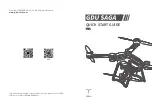
II. Preparations for Flying
1. Before flying, please check whether the aircraft is intact, whether the rotation direction of all the
propellers are right, whether the motors and propellers are fixed well. Overload is strictly prohibited
and the maximum load is about 1.3kg.
2. Power on aircraft and check whether batteries can provide sufficient power. If LEDs under the
four arms of the aircraft flash or blink, this indicates batteries cannot provide enough power for the
flying. Replace the batteries. Make sure batteries are fully charged. (Lipo 3s 12.55v 2200mAh)
What's more, the transmitter will beep if its battery suffers a low voltage.
3. Be sure to observe the surroundings before flying. Choose an open space without obstruction and
tall buildings as flying field. Stay away from crowds, especially children. Place the aircraft over 4
meters away from you and others to avoid accidental injuries.
4
、
we suggest the operator choose an open space without crowds and tall buildings as flying field.
Safety comes first. Be Sure to protect your eyes and other vulnerable parts of your body. We
strongly suggest you wear an eye shield to protect your eyes.
I.Flying warnings
1. For the first flying, beginners are strongly suggested taking necessary trainings by
professionals or doing some pre-exercises on simulators until you can skillfully operate the aircraft
or the simulator and the
remote controller
2. During flying, please make sure that rotorcraft is always within sight and its back light always
faces its operator so that he could determine its flight attitude and adjust its flight directions when
necessary.
3. During flying, what's more, please watch the blinks of LEDs under the four arms of the aircraft at
any time and keep alert to Low-Voltage signals. Low-Voltage Alert is to indicate that the battery
cannot provide enough power for the aircraft and
to warn you to land the aircraft
it is triggered
ASAP
to avoid or reduce crashes or other harmful consequences. There are two levels of low voltage
protection. (Level I) when the LEDs flash once every 1.5 seconds, this indicates battery voltage is
low. When the LEDs flash once every half a second, this indicates battery voltage is very low and
you should land the aircraft as soon as possible. It is not for fun.
4. Sensors in the heart of aircraft are damageable, so be sure not to hit or drop the aircraft heavily.
Otherwise, the inertial measuring unit (IMU) might be destroyed. If aircraft fi ie s in an abnormal way
after being hit or dropped, please return it to Speedwolf f light to repair immediately.
1. Make clear the nose and tail of the aircraft and make sure the back light of the aircraft faces
towards the operator. Switch on the remote controller, perform the basic self-calibration and then
power on the aircraft. Unlock and start the motors and then check whether all the four propellers are
rotating correctly. If all the propellers work well, then release the right stick and keep it at the mid
point in a natural state. Pull the throttle stick (left stick) to the mid bottom point and then keep raising
the throttle stick from the bottom until rotorcraft takes off from the ground. By pushing or pulling the
throttle stick, rotorcraft can ascend or descend in the air.
2. After flying in the air, rotorcraft mi ght suffer side drift or nose rotation. Please use the Yaw stick
(left stick) to adjust the back light direction and keep it facing towards the operator. Make sure the
aircraft and the transmitter are in the same frame of reference and pull or push the roll and pitch
stick (right stick) to adjust the flying directions.
III.Taking off
5



























